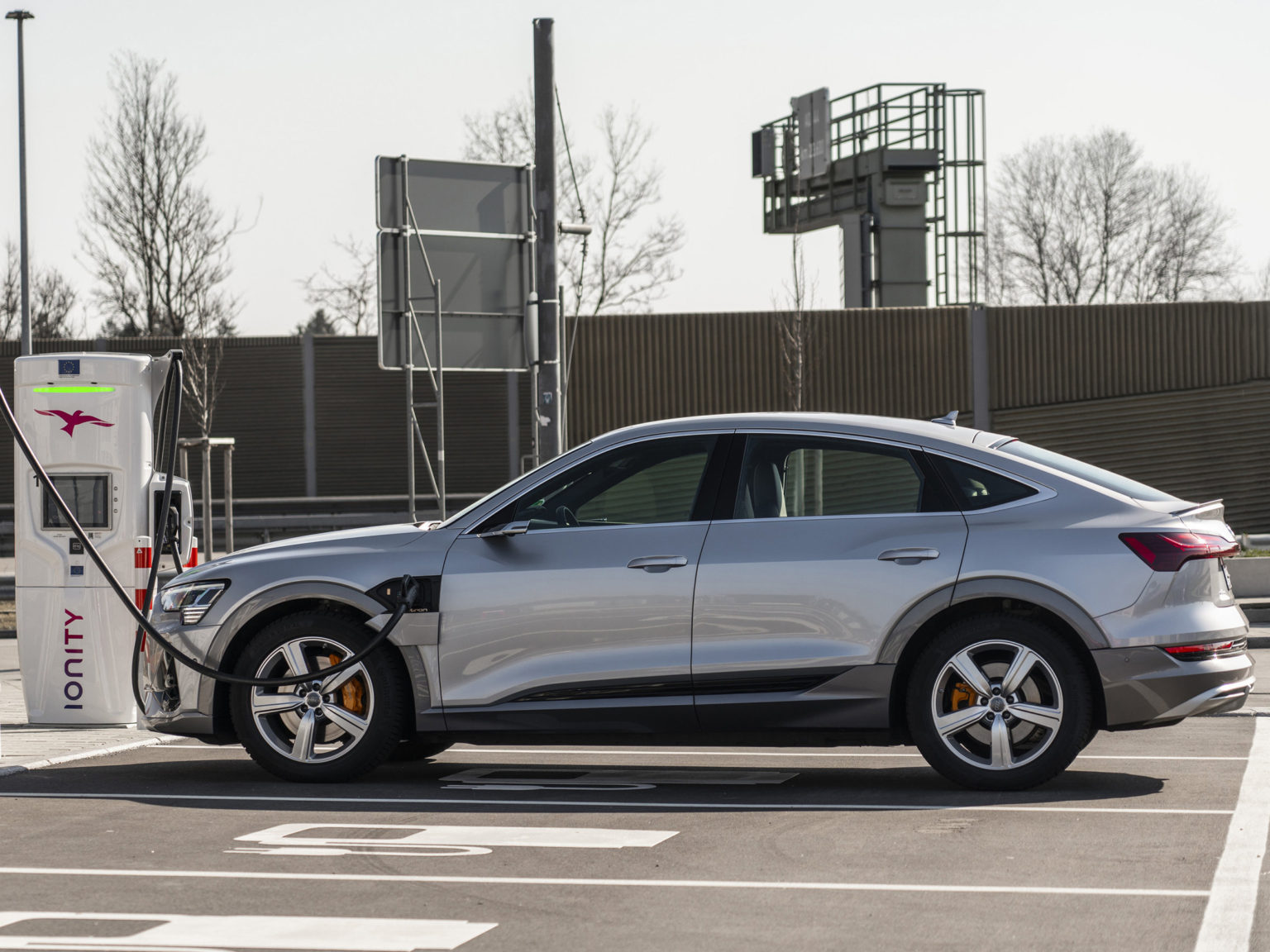Should you be worried about the car’s range? How fast it can charge? What does it all mean? Why does it matter? Navigating electric vehicle (EV) terminology and measurements can be tough for industry enthusiasts let along the average consumer.
According to Audi, most electric vehicle charging happens at home or work. Generally speaking, charging time does not play a factor during those periods because the model is parked for an extended period of time. Here, the most important thing to consider is how fast you can charge your vehicle at home. How fast a vehicle charges to full depends on the amount you drive your EV and the type of outlet you plug it into to charge.
The Audi E-Tron is capable of High Power Charging.Photo courtesy of Audi AG
Your EV may be capable of charging at a high rate of speed. However, if your power outlet doesn’t allow for the transmission of energy at that high rate, your car won’t charge at that rate. There are three main levels of electric vehicle charging:
- Level 1 – This type of charting happens via a 120-volt AC plug (a typical household outlet connection) and does not require any additional equipment. Generally, this type of charge can deliver two to five miles of range per hour.
- Level 2 – These connects are either 240-volt (household) or 208-volt (commercial). This is the type of plug that you would typically use for high-energy appliances like a refrigerator or washing machine. These plugs are typically found inside homes, and not in locations that are easily accessible by vehicle charging cord. This outlet can deliver 10 to 20 miles of range per hour, on average.
- DC Fast Charge – This type of outlet can conduct 480 volts of AC and requires specialized equipment to utilize. It’s called “fast charge” for a reason. Vehicles can get 60 to 80 miles of range in just 20 minutes. Most often, these connections are available at public charging locations.
Charging capacity is measured in kilowatt-hours (kWh). When you are shopping for a new EV, you’ll see that it is listed as have a certain kWh battery (example: 16 kWh). The reason that batteries are not listed by size is because they consist of a variety of cells. The size of the cells and the chemistry of the material in those cells determines how quickly they expend energy and how quickly they can be recharged.
This is how Nissan is able to have the same size battery in the Leaf and Leaf Plus but the Leaf Plus delivers more range.
Audi has detailed how its E-Tron SUV charges versus its competitors.Photo courtesy of Audi AG
Audi is touting the ability of its vehicles to get energy via High Power Charging (HPC). HPC was developed by Phoenix Contact and dictates how quickly a vehicle can charge. The tech allows cars to reclaim a driving range of 100 kilometers in three to five minutes.
The biggest restriction on fast charging abilities is the transfer of heat. The faster the charge, generally, the higher the amount of heat that is produced. Batteries can only take so much heat before they degrade or malfunction.
This creates a tightrope for automakers and battery providers to walk. They need to have a battery with enough range to make the buying public feel comfortable that will charge as fast as possible without damaging the vehicle or the battery itself. The cost and weight of the battery are two additional considerations.
To achieve this mix, many EV charging systems are designed to allow vehicles to charge to 80 percent quickly, but then throttle off the speed and, correspondingly, the heat. The amount of time a vehicle can charge at this high rate is defined as its charging capacity.
Having a high charging capacity means that you can charge faster for longer. Without high charging capacity, the charging speed matters, but not as much.
The rate at which a vehicle throttles up then throttles back down its charging speed is known as the charging curve. Audi advises that an ideal charging curve with maximum output available for a long period of time is the more substantial area that customers should be concerned about. Having a short charge time means less time plugged in, freeing up public charging stations.
Audi offers up for example its E-Tron 55:
“For a range of around 110 kilometres (68 miles), the customer ideally spends just under 10 minutes at the charging terminal. The Audi e-tron 55 reaches the 80% mark after approximately 30 minutes. Even though it takes much longer, for technical reasons, to fill the remaining 20 percent of a lithium-ion battery, fully charging (5% to 100% state of charge) at an HPC terminal takes around 45 minutes.
The lithium-ion battery of the Audi e-tron 55 has a gross capacity of 95 kWh… Liquid cooling ensures that the battery’s temperature remains in the optimum range of 25 to 35 degrees Celsius, even at high stress levels or low temperatures. 22 litres of coolant circulates in the total of 40 metres of cooling lines in the four coolant circuits. During direct-current charging with 150 kW, cold coolant takes away the heat that occurs as a result of electrical internal resistance in the battery.”
If you cannot charge to the highest advised limit of the vehicle’s capability due to a lack of charging infrastructure, it doesn’t matter so much about charging capacity. In that instance, charging speed is most important.
This is the Audi E-Tron 55’s charging curve.Photo courtesy of Audi AG
Is a Level 2 charger enough for your needs because when you charge you often charge for hours at a time? Are you in need of fast charging because you’re on a road trip and don’t want to wait around for hours while your vehicle charges?
Just as automakers are walking the tightrope, so too are those in charge of installing charging stations.









